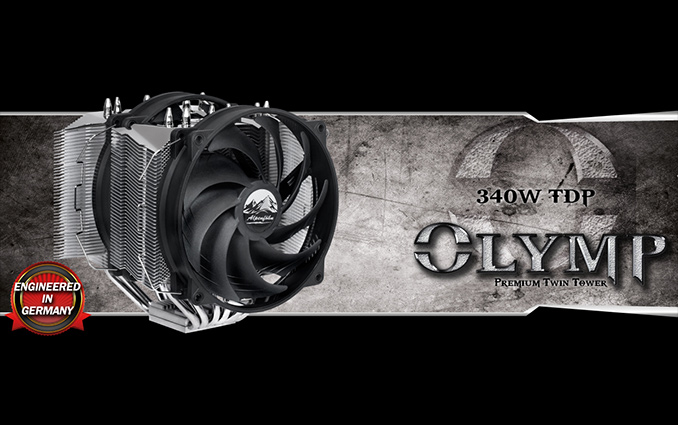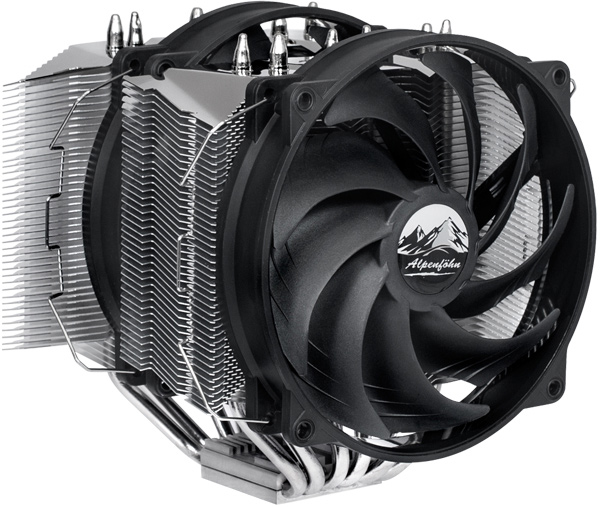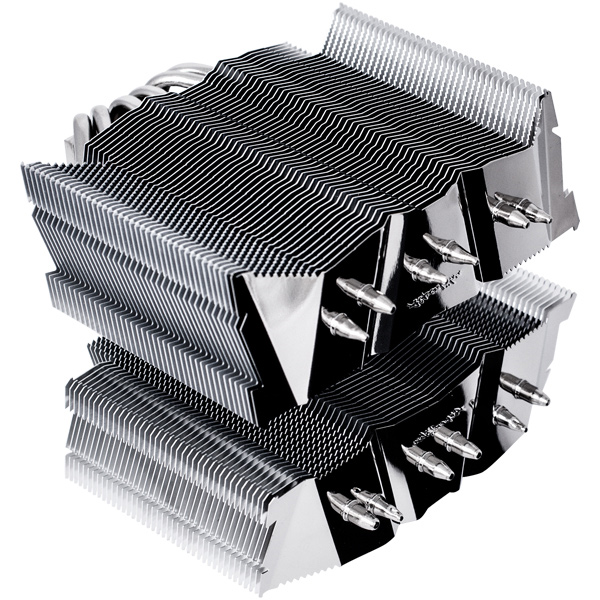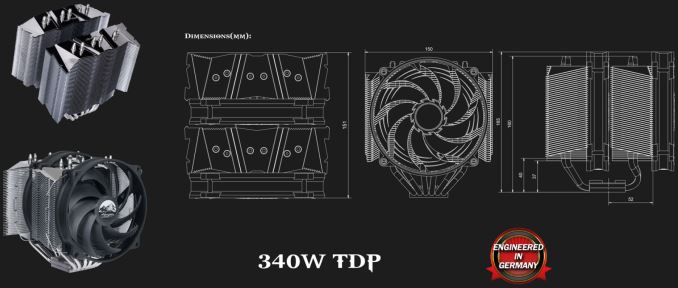Alpenföhn Unveils Olymp: A Giant Air Cooler Rated for 340W TDP
by Anton Shilov on February 4, 2016 10:00 AM EST- Posted in
- Cases/Cooling/PSUs
- AMD
- Intel
- Cooler
- Alpenföhn
- Alpenfoehn
- Olymp

As the market for PC CPU coolers has matured over the last half-decade or so and closed loop liquid coolers have encroached in the space, we haven't seen very many announcements of high-end CPU air coolers. However when we do see new coolers announced, they tend to aim for the stars, and now cooler manufacturer Alpenföhn is doing just that. This week the company is announcing their new Olymp cooler, a rather large tower CPU cooler rated to dissipate up to 340W of heat.
The Alpenföhn Olymp is an oversized asymmetric twin-tower cooler made of aluminum with a nickel-plated copper base as well as six U-shaped 6-mm nickel-plated heat-pipes. The heatsink is 165x151x150mm in size and weighs 1.2 kilograms (without fans); it requires a special mounting mechanism with custom retention plates and will not fit into many small form-factor PC cases (especially with fans installed). The sides of the fins of the heatsink are slightly bent in order to make the most of their surface area and to optimize airflow.
Alpenföhn does not disclose exact cooling fin surface area of the Olymp, but it is pretty clear that it is huge. While heatsinks of such weight and dimensions can cool-down even higher-end CPUs passively (for example, Thermalright positions its HR22 and Macho Zero as passive cooling solutions), the Alpenföhn Olymp can be equipped with 140-mm fans to maximize its potential. Since the cooler is gargantuan, to ensure maximum compatibility with memory modules Alpenföhn proposes installing one fan between the towers and another on the backside of the cooler. Such configuration is common for oversized coolers and it's a rather straightforward solution for dual-channel memory platforms (i.e., LGA115x, FM2/AM3, etc.). However users of quad-channel memory platforms (i.e., LGA2011, where modules are installed on both sides of the CPU socket) will have to adjust height of front and/or back fans so not restrict the installation of memory modules in slots that need to be used.
The Alpenfoehn Olymp is shipped with two WingBoost 140-mm fans with PWM control that have 300 – 1400 RPM speed and can push up to 123.38 m3 of air per hour. The airflow pressure of Olymp’s fans is slightly lower than that of the competing Noctua NH-D15 (140.2 m3/h), but with a heatsink that large, it shouldn't matter much for the vast majority of real-world use cases. The fans are rated to produce from 8 to 26.8 dbA of noise — just slightly louder than the maximum amount noise declared for the NH-D15. Alpenföhn rates its fans for 280 thousand hours MTTF (mean time till failure), or about 32 years of 24/7 operation.
The manufacturer believes that its Olymp cooler can effectively dissipate up to 340 W of heat, an extreme amount that greatly exceeds any reasonable TDP of a commercial chip. The Alpenfoehn Olymp will compete against other super-coolers, including Thermalright SilverArrow Extreme (officially rated for 320 W TDP), as well as advanced liquid cooling solutions.
The Alpenföhn Olymp is compatible with virtually all modern CPU platforms, including Intel’s LGA115x, LGA2011 and LGA775 as well as AMD’s AM2/AM3 and FM1. Keeping in mind its huge dimensions and weight, it makes a lot of sense to check thoroughly whether the cooler is compatible with a particular setup before purchase. The cooler is available for €79.9 in various stores across Europe.













47 Comments
View All Comments
willis936 - Thursday, February 4, 2016 - link
This should only be considering on a 130+W TDP part you plan on overclocking by a healthy amount. Honestly short of an 8 core intel HEDT I wouldn't even consider it I wanted to push past 4.5 GHz.xthetenth - Thursday, February 4, 2016 - link
That level of cooler is pretty good if you want to have your fans start ramping at 40C and the chip stay at 45 C.Sivar - Friday, February 5, 2016 - link
It would probably work as a passive cooler from sheer size, but it's a very poor design for passive.A good passive design has widely spaced fins which are aligned such that, as heat rises, maximum air passes between the fins.
Even better designs use ice pipes, but I honestly do not know how they work. The only examples I know of are NoFan's passive coolers, which are absolutely fantastic though a little pricey.
DIYEyal - Thursday, February 4, 2016 - link
That is awesome! I wonder how does it compare with my D15r3loaded - Thursday, February 4, 2016 - link
At this point an AIO water cooler would be a more sensible option.KateH - Thursday, February 4, 2016 - link
Not necessarily at this *price* point though... I haven't really checked the latest crop, but I doubt an AIO water unit that costs the same 80€ as this would be better. Even a 30$ Hyper 212 EVO can run with AIO watercoolers that cost 3x as much."sensible" as in, "more elegant and compact", then yes absolutely. This this is a monstrosity.
Dribble - Friday, February 5, 2016 - link
Cheap AIO water coolers are overrated. You have additional noise in the water pump and a two additional points of failure (pump and leakage/evaporation). If you do water cooling properly with a big expensive custom set-up to cool your cpu and gpu it's worth it, otherwise something like this for $80 is not a bad idea.KateH - Thursday, February 4, 2016 - link
The overkill TDP rating is just begging for Thermoelectrics. 340W is plenty to soak up around 150W of CPU heat + the waste power of the element I reckon. A ludicrous proposition to be sure, but hey! With a judiciously-placed bead of silicone and plenty of 15v DC, one could have a daily-use subzero proc- and that's pretty neat.xrror - Saturday, February 6, 2016 - link
Are pelts (peltiers) even viable anymore in the overclocking space? Honest I'm not trying to troll, I'm just so out of the loop on them these days. To mark my age/ignorance the last pelts I remember where when the Athlon Thunderbirds at 1.5Ghz plus (1.7Ghz AXIA) exceeded the 200w pelts offered at the time where you just couldn't get the heat out reasonably from the stack. Cause argh 400w out the back was just too damn much, and the pelt was an insulator (not a slam on the pelt, those levels are insane).I know pelts were then used for water chillers in loops, but yea. Plus like you said pelts weren't 12v, more like 15-18v... and you can't do the "-5v to +12v" PSU trick nowadays (though, I seriously doubt any PSU of the era would appreciate 200w+ "flowing" through that even then legacy -5v. Hey guys! It's the ISA card from HELL).
After all that, I like the cut of your jibe heheh... but yea I'm genuinely interested in if there have been more recent attempts to get peltiers back in the game. I know CoolerMaster had the V8 heatsinks (which they deserve credit for that) which... I need to research more now to see if anyone modded one to run it "flat out") I never saw any articles where it was an amazing advance over any good twin tower cooler or 120x2 AIO cooler.
Klimax - Friday, February 5, 2016 - link
Maybe good replacement for my CNPS12X. (Cooling my i7-5960x, currently at 4,2GHz)